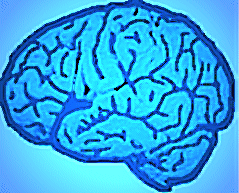
Neuroscience: A Journey Through the Brain
 |
Neuroscience: A Journey Through the Brain |
| Main Page Organization Development Neuron Systems About the site (Glossary) References |
Basic Anatomy of the Nervous System
| Organization Home Basic Anatomy Nervous System (Picture of Systems) Lobes of the Brain |
Jump to section: Cell Types | Matter Types | Nuclei and Tracts
Cell Types (back to top)
The germinal cells, or stem cells, of an embryo give rise to two different types of nervous system cells. Neurons, or nerve cells, are the cells that form the functional units of the nervous system that arise from neuroblasts (a blast is an immature cell). Glial cells provide support functions to neurons and arise from spongioblasts. There are many types of both neurons and glia, as discussed below. For mor einformation on neuron classification, see the Neuron : Classification page
| Type of Nervous System Cell | Type of Neuron or Glial Cell | Function |
|
Neuron
|
Bipolar cell | Found in the retina (eye). Assists in the transduction of light into a neural impulse. |
| Somatosensory cell | Found in the skin. Involved with the tactile senses, such as touch, kinesthesia, pain, and proprioception. | |
| Motor cell | The cell body is found in the spinal cord, and the neuron projects to the muscles. | |
| Pyramidal cell | Found in the cortex. They have a pyramid-shaped cell body and send information from the cortex to another brain area. | |
| Purkinje cell | Found in the cerebellum. The cerebellum is mainly involved in the learning of motor skills. | |
| Association cell | Found in the thalamus. Acts to connect other neurons passing through the thalamus. | |
|
Glial Cell
|
Astroglia | Provides structural support and repairs neurons. |
| Oligodendroglia | Insulate and speed transmission of central nervous system (CNS) neurons. | |
| Schwann Cells | Insulate and speed transmission of perpheral nervous system (PNS) neurons. | |
| Microglia | Perform phagocytosis (of damaged or dead cells). | |
| Ependymal cells | Line the brain's ventricles and produce cerebrospinal fluid. |
Matter Types (back to top)
The different parts of the nervous system typically appear gray, white, or mottled. Gray matter consists of regions of capillary blood vessels and neuron cell bodies. White matter consists of regions of axons (the process extending from a neuron's cell body) that are generally covered with a layer of glial cells (see above). Reticular matter, which appears mottled, is an area where cell bodies and axons are mixed.
Nuclei and Tracts (back to top)
In the CNS, a large number of cell bodies grouped together are called a nucleus. These nuclei each have a particular function. For example, the medial geniculate nucleus in the thalamus is one part of the auditory pathway. Nuclei typically appear gray (see gray matter above) because of the cell bodies.
A large collection of axons in the CNS is referred to as a tract or a fiber pathway. These tracts carry information from one place to another in the brain, much like axons do. For example, the optic tract carries information from the eyes to the occipital lobe in the brain.
Created and Maintained by: Melissa
Davies
Last Updated: April 09, 2002 08:59 PM